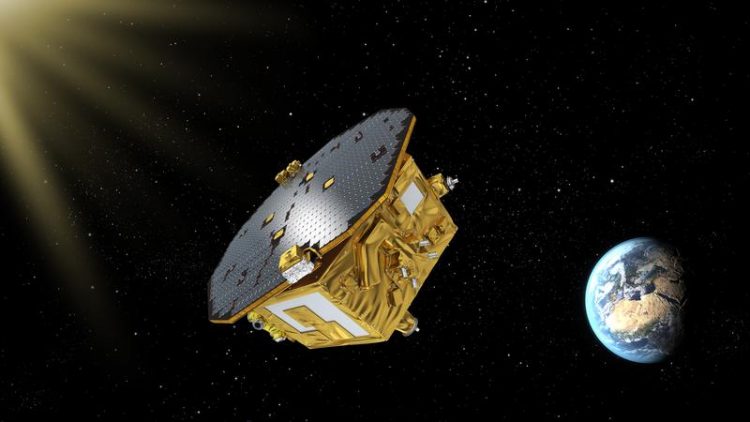Outer space mission LISA Pathfinder: Fraunhofer IZFP puts two gold/platinum cubes to the acid test

LISA Pathfinder in outer space ESA–C. Carreau
Just on this account, the European Space Agency has sent a satellite into space which is to perform the preparatory work for the direct detection of gravitational waves predicted by Einstein. The central experiment of the mission involves two virtually identical high-precision cubes made of a gold-platinum alloy. These cubes were tested by engineers at Fraunhofer IZFP for their suitability and accuracy, both prerequisites for their smooth operation in space.
LISA Pathfinder is a pre-project of a possible LISA-like mission, which is to track down both, gravitational waves and, in particular, their sources in deep space: Since December 2015, the LISA Pathfinder satellite (Laser Interferometer Space Antenna) was traveling in the outer space to its final orbit. Mid-February, approximately one and a half million kilometers from Earth, LISA Pathfinder carried out the last function tests of the scientific payload.
In early March, the actual, six-month mission is to begin. LISA Pathfinder has been approved by the “Science Programme Committee” of the ESA in November 2000 and launched on December 3, 2015.
Amongst others, two gold-platinum cubes serving as test masses are on board, each being held in a separate vacuum vessel. After reaching the final position in space they are released and then, positioned in zero gravity, floating freely.
Their respective positions – the cubes float in 38 cm distance from each other – have to be stable with considerable precision and must be monitored accordingly. The measurement of the relative accuracy of the positioning in the picometer range is crucial for the success of future gravitational wave experiments.
Another serious criterion for measuring the gravitational waves is given by the shape accuracy of the cubes’ surface structure: Both cubes must have one extremely precisely shaped surface whose deviation from the ideal shape is subject to extremely narrow limits. Only within these limits the provided measures can succeed.
With regard to the fulfillment of these extreme requirements both two kilogram cubes were put to the acid test by Fraunhofer IZFP’s engineers and scientists: In the test laboratories of this Saarland Institute high-frequency ultrasound examinations of the gold cubes’ near-surface regions were carried out, which are able to detect hidden cavities and inclusions down to a scale of 50 micrometers.
These investigations resulted in insights concerning the question of whether the cubes’ gravitational homogeneity is sufficient. Likewise, they substantially affected the decision of which side of each cube is to be processed further to “specular surfaces”.
Background information concerning LISA Pathfinder and gravitational waves:
Beside ESA research institutes and industrial enterprises from Italy, Germany, UK, Spain, Switzerland, France and Netherlands participate in LISA Pathfinder (information by Deutsches Raumfahrtzentrum DLR).
As a space systems company Airbus Defence and Space GmbH (Friedrichshafen) is responsible for system integration and verification of the “LISA Technology Package” (LTP) instrument. The subsystems and modules of LTP are provided via the national space agencies and the European Space Agency by a consortium of European companies and research institutes such as the Max Planck Institute for Gravitational Physics or the Albert Einstein Institute in Hannover (AEI).
Media Contact
All latest news from the category: Earth Sciences
Earth Sciences (also referred to as Geosciences), which deals with basic issues surrounding our planet, plays a vital role in the area of energy and raw materials supply.
Earth Sciences comprises subjects such as geology, geography, geological informatics, paleontology, mineralogy, petrography, crystallography, geophysics, geodesy, glaciology, cartography, photogrammetry, meteorology and seismology, early-warning systems, earthquake research and polar research.
Newest articles

Silicon Carbide Innovation Alliance to drive industrial-scale semiconductor work
Known for its ability to withstand extreme environments and high voltages, silicon carbide (SiC) is a semiconducting material made up of silicon and carbon atoms arranged into crystals that is…

New SPECT/CT technique shows impressive biomarker identification
…offers increased access for prostate cancer patients. A novel SPECT/CT acquisition method can accurately detect radiopharmaceutical biodistribution in a convenient manner for prostate cancer patients, opening the door for more…

How 3D printers can give robots a soft touch
Soft skin coverings and touch sensors have emerged as a promising feature for robots that are both safer and more intuitive for human interaction, but they are expensive and difficult…




















